Mapping Benggang Erosion Susceptibility: An Analysis of Environmental Influencing Factors Based on the Maxent Model
Abstract
1. Introduction
2. Materials and Processing
2.1. Study Area
2.2. Environment Variable Selection and Data Source
- (1)
- Elevation
- (2)
- Slope gradient
- (3)
- Slope aspect
- (4)
- Surface roughness
- (5)
- Topographic wetness index
- (6)
- Catchment Area
- (7)
- Rainfall Erosivity
- (8)
- Fractional Vegetation Cover
- (9)
- Lithology
- (10)
- Soil and Water Conservation Measures
3. Modeling Approaches and Validation
3.1. Model Description: Maxent and Random Forest
3.2. Variable Integration and Result Grading
3.3. ROC Analysis and Spatial Autocorrelations
4. Results
4.1. Importance Analysis of Environmental Variables
4.2. Interpretation of Environmental Variables on the Benggang Erosion Susceptibility
4.3. Susceptibility Evaluation Results and Comparisons
5. Discussion
5.1. Typical High-Susceptibility Regions Identified
5.2. Absence Sample Acquisition and Variable Processing
6. Conclusions
Author Contributions
Funding
Institutional Review Board Statement
Informed Consent Statement
Data Availability Statement
Acknowledgments
Conflicts of Interest
References
- Pimentel, D. Soil Erosion: A Food and Environmental Threat. Environ. Dev. Sustain. 2006, 8, 119–137. [Google Scholar] [CrossRef]
- García-Ruiz, J.M.; Beguería, S.; Nadal-Romero, E.; González-Hidalgo, J.C.; Lana-Renault, N.; Sanjuán, Y. A Meta-Analysis of Soil Erosion Rates across the World. Geomorphology 2015, 239, 160–173. [Google Scholar] [CrossRef]
- Igwe, P.U.; Onuigbo, A.A.; Chinedu, O.C.; Ezeaku, I.I.; Muoneke, M.M. Soil Erosion: A Review of Models and Applications. Int. J. Adv. Eng. Res. Sci. 2017, 4, 138–150. [Google Scholar] [CrossRef]
- Nearing, M.A.; Xie, Y.; Liu, B.; Ye, Y. Natural and Anthropogenic Rates of Soil Erosion. Int. Soil Water Conserv. Res. 2017, 5, 77–84. [Google Scholar] [CrossRef]
- Borrelli, P.; Robinson, D.A.; Fleischer, L.R.; Lugato, E.; Ballabio, C.; Alewell, C.; Meusburger, K.; Modugno, S.; Schütt, B.; Ferro, V.; et al. An Assessment of the Global Impact of 21st Century Land Use Change on Soil Erosion. Nat. Commun. 2017, 8, 2013. [Google Scholar] [CrossRef] [PubMed]
- Jiongxin, X. Benggang Erosion: The Influencing Factors. CATENA 1996, 27, 249–263. [Google Scholar] [CrossRef]
- Wei, Y.; Liu, Z.; Wu, X.; Zhang, Y.; Cui, T.; Cai, C.; Guo, Z.; Wang, J.; Cheng, D. Can Benggang Be Regarded as Gully Erosion? CATENA 2021, 207, 105648. [Google Scholar] [CrossRef]
- Zhang, W.; Yuan, Z.; Li, D.; Zheng, M.; Liao, Y.; Cai, Q.; Huang, Y.; Cai, C.; Niu, D.; Wang, Q. Discussion of the “Benggang” concept and its English translation. Sci. Soil Water Conserv. 2020, 18, 136–143. [Google Scholar] [CrossRef]
- Liang, Y.; Yang, X.; Pan, Z.; Zhang, B.; Shi, D. Characteristics and control measures of soil and water loss in southern hilly region of red soil. Soil Water Conserv. China 2008, 12, 50–53. [Google Scholar] [CrossRef]
- Zhong, B.; Peng, S.; Zhang, Q.; Ma, H.; Cao, S. Using an Ecological Economics Approach to Support the Restoration of Collapsing Gullies in Southern China. Land Use Policy 2013, 32, 119–124. [Google Scholar] [CrossRef]
- Feng, H.; Liao, C.; Li, S.; Lu, S. Investigation on status of benggang erosion in southern China. Yangtze River 2009, 40, 66–75. [Google Scholar] [CrossRef]
- Liang, Y.; Ning, D.; Pan, X.; Li, D.; Zhang, B. Characteristics and treatment of benggang erosion in southern red soil region. Soil Water Conserv. China 2009, 1, 31–34. [Google Scholar] [CrossRef]
- Zhu, X.; Gao, L.; Wei, X.; Li, T.; Shao, M. Progress and Prospect of Studies of Benggang Erosion in Southern China. Geoderma 2023, 438, 116656. [Google Scholar] [CrossRef]
- Wu, Y.; Li, N.; Wang, X.; Cui, J.; Chen, Y.; Wu, Y.; Yamamoto, H. Experimental Investigation on Mechanical Behavior and Particle Crushing of Calcareous Sand Retrieved from South China Sea. Eng. Geol. 2021, 280, 105932. [Google Scholar] [CrossRef]
- Wu, Y.; Yamamoto, H.; Cui, J.; Cheng, H. Influence of Load Mode on Particle Crushing Characteristics of Silica Sand at High Stresses. Int. J. Geomech. 2020, 20, 04019194. [Google Scholar] [CrossRef]
- Zhang, S.; Zhong, C. The mechanism and types of the benggang forming in Guangdong province. Bull. Soil Water Conserv. 1990, 3, 8–16. [Google Scholar] [CrossRef]
- Deng, Y.; Shen, X.; Xia, D.; Cai, C.; Ding, S.; Wang, T. Soil Erodibility and Physicochemical Properties of Collapsing Gully Alluvial Fans in Southern China. Pedosphere 2019, 29, 102–113. [Google Scholar] [CrossRef]
- Deng, Y.; Duan, X.; Ding, S.; Cai, C. Effect of Joint Structure and Slope Direction on the Development of Collapsing Gully in Tuffaceous Sandstone Area in South China. Int. Soil Water Conserv. Res. 2020, 8, 131–140. [Google Scholar] [CrossRef]
- Gao, C.; Li, P.; Hu, J.; Yan, L.; Latifi, H.; Yao, W.; Hao, M.; Gao, J.; Dang, T.; Zhang, S. Development of Gully Erosion Processes: A 3D Investigation Based on Field Scouring Experiments and Laser Scanning. Remote Sens. Environ. 2021, 265, 112683. [Google Scholar] [CrossRef]
- Local Standard Information Service Platform. Available online: https://dbba.sacinfo.org.cn/stdDetail/5805d01e1052d1b2e8387ca6c5cef746c7c623d7f33e99a61ea33f0ee8bd8b90 (accessed on 10 May 2024).
- General Office of the CPC Central Committee and General Office of the State Council issued Opinions on Strengthening Soil and Water Conservation in the New Era. Available online: https://www.gov.cn/gongbao/content/2023/content_5738894.htm (accessed on 10 May 2024).
- Liao, Y.; Tang, C.; Yuan, Z.; Zhuo, M.; Huang, B.; Nie, X.; Xie, Z.; Li, D. Research Progress on Benggang Erosion and Its Prevention Measure in Red Soi Region of Southern China. Acta Pedol. Sin. 2018, 55, 1297–1312. [Google Scholar]
- Xie, F.; Liang, Z.; Deng, Y.; Li, M.; Cai, Z.; Huang, Z. Spatial Distribution Characteristics and Control Measures of Different Forms of Collapsing Slopes in Guangxi. Soil Water Conserv. China 2020, 7, 53–57+5. [Google Scholar] [CrossRef]
- Chen, Y. Sensitivity Analysis of River Basin Collapsed Gully Based on RS and GIS. Master’s Thesis, Fujian Normal University, Fuzhou, China, 2010. Available online: https://chn.oversea.cnki.net/KCMS/detail/detail.aspx?dbcode=CMFD&dbname=CMFD2012&filename=1011062084.nh&uniplatform=OVERSEA&v=0U5BNMqXMwn3yh_Q9ruoPUcMxRhaQNIyMLDaWiVY6MgDpjSNRJLAiwKqZxJ57VnG (accessed on 10 May 2024).
- Ji, X.; Huang, Y.; Lin, J.; Jiang, F.; Chen, J. Sensitivity assessment method of collapsed gully occurrence in granite region of South China based on niche-fitness. J. China Agric. Univ. 2017, 22, 159–168. [Google Scholar] [CrossRef]
- Cheng, D.; Zhang, P. Conception of Risk Assessment of Collapse Gully Erosion in South China. Bull. Soil Water Conserv. 2016, 36, 346–350. [Google Scholar] [CrossRef]
- Cheng, D.; Zhao, Y.; Zhang, P.; Zhao, J. Risk Assessment of Collapse Gully Erosion in Jiangxi Province Based on Bivariate Statistical Analysis of Entropy Information. J. Chang. River Sci. Res. Inst. 2019, 36, 27–32+38. [Google Scholar] [CrossRef]
- Sun, K.; Cheng, D.; He, J.; Zhao, Y. Comparative Study on Risk Assessment Methods for Collapse Gully Erosion: A Case of Guangdong Province. Soil Water Conserv. China 2018, 3, 51–54+69. [Google Scholar] [CrossRef]
- Sun, K.; Cheng, D.B.; He, J.J.; Zhao, Y.L. Comparison of Two Occurrence Risk Assessment Methods for Collapse Gully Erosion —A Case Study in Guangdong Province. Iop Conf. Ser. Earth Environ. Sci. 2018, 113, 012209. [Google Scholar] [CrossRef]
- Guan, J.; Huang, Y.; Lin, J.; Jiang, F.; Yao, Y.; Ji, X. Comparisons Between Benggang Risk Assessments Based on Information Model and Random Forest Model. Mt. Res. 2021, 39, 539–551. [Google Scholar] [CrossRef]
- Wei, Y.; Wu, X.; Wang, J.; Yu, H.; Xia, J.; Deng, Y.; Zhang, Y.; Xiang, Y.; Cai, C.; Guo, Z. Identification of Geo-Environmental Factors on Benggang Susceptibility and Its Spatial Modelling Using Comparative Data-Driven Methods. Soil Tillage Res. 2021, 208, 104857. [Google Scholar] [CrossRef]
- Guo, F.; Lai, P.; Chen, Y.; Wang, X.; Xia, D.; Cao, Y. Influence of Different Environmental Factor Connection Methods on Benggang Susceptibility Assessment. Bull. Soil Water Conserv. 2022, 42, 123–130. [Google Scholar] [CrossRef]
- Guo, F.; Wu, D.; Wang, X.; Dai, Q.; Lai, Z.; Chen, Y.; Xia, D. Susceptibility Assessment of Benggang Based on Random Forests Model and Geodetector in Xingguo County of South Jiangxi. J. China Three Gorges Univ. 2023, 45, 44–50. [Google Scholar] [CrossRef]
- Guo, F.; Jiang, G.; Huang, X.; Wang, X.; Xia, D.; Chen, Y.; Li, X. Impact of environmental factor combinations and negative samples election on Benggang susceptibility assessment in granite areas. Trans. Chin. Soc. Agric. Eng. 2024, 40, 191–200. [Google Scholar] [CrossRef]
- Guo, F.; Zhang, J.; Shan, H.; Cheng, D.; Li, X.; Xia, D.; Chen, Y. Evaluation of the Susceptibility to Benggang in Shicheng County, Ganzhou City Under Different Raster Cell Resolutions. J. China Three Gorges Univ. 2024, 46, 63–70. [Google Scholar] [CrossRef]
- Dou, J.; Yunus, A.P.; Bui, D.T.; Merghadi, A.; Sahana, M.; Zhu, Z.; Chen, C.-W.; Han, Z.; Pham, B.T. Improved Landslide Assessment Using Support Vector Machine with Bagging, Boosting, and Stacking Ensemble Machine Learning Framework in a Mountainous Watershed, Japan. Landslides 2020, 17, 641–658. [Google Scholar] [CrossRef]
- Phillips, S.J.; Dudık, M. Modeling of Species Distributions with Maxent: New Extensions and a Comprehensive Evaluation. Ecography 2010, 31, 161–175. [Google Scholar] [CrossRef]
- Kornejady, A.; Ownegh, M.; Bahremand, A. Landslide Susceptibility Assessment Using Maximum Entropy Model with Two Different Data Sampling Methods. CATENA 2017, 152, 144–162. [Google Scholar] [CrossRef]
- Qu, X.; Li, D.; He, Y.; Yu, L.; Yan, W. Evaluation of Landslide Susceptibility Based on MaxEnt Model—Taking Panzhihua City as an Example. Res. Soil Water Conserv. 2021, 28, 224–229. [Google Scholar] [CrossRef]
- Wu, B.; Qi, S.; Guo, Z.; Hu, Y. Attribution of Superficial Landslide Risk of Forestland in Huaying MountainsBased on MaxEnt Model. Sci. Silvae Sin. 2024, 60, 32–46. [Google Scholar]
- Pandey, V.K.; Pourghasemi, H.R.; Sharma, M.C. Landslide Susceptibility Mapping Using Maximum Entropy and Support Vector Machine Models along the Highway Corridor, Garhwal Himalaya. Geocarto Int. 2020, 35, 168–187. [Google Scholar] [CrossRef]
- Yang, X.; Jin, X.; Zhou, Y. Wildfire Risk Assessment and Zoning by Integrating Maxent and GIS in Hunan Province, China. Forests 2021, 12, 1299. [Google Scholar] [CrossRef]
- Gwitira, I.; Murwira, A.; Masocha, M.; Zengeya, F.M.; Shekede, M.D.; Chirenda, J.; Tinago, W.; Mberikunashe, J.; Masendu, R. GIS-Based Stratification of Malaria Risk Zones for Zimbabwe. Geocarto Int. 2019, 34, 1163–1176. [Google Scholar] [CrossRef]
- Lin, J.; He, P.; Yang, L.; He, X.; Lu, S.; Liu, D. Predicting Future Urban Waterlogging-Prone Areas by Coupling the Maximum Entropy and FLUS Model. Sustain. Cities Soc. 2022, 80, 103812. [Google Scholar] [CrossRef]
- Wuhua County People’s Government Portal. Available online: https://www.wuhua.gov.cn/xxgk/index.html (accessed on 13 May 2024).
- Liao, Y.; Yuan, Z.; Li, D.; Zheng, M.; Huang, B.; Xie, Z.; Wu, X.; Luo, X. What Kind of Gully Can Develop into Benggang? CATENA 2023, 225, 107024. [Google Scholar] [CrossRef]
- Wu, Z.; Deng, N.; Wang, J. Erosion Geomorphology and Process in Avalanching Hill Areas. Soil Water Conserv. China 1999, 4, 12–14+48. [Google Scholar] [CrossRef]
- Wu, Z.; Li, D.; Qiu, S. Systematic Analysis of Slope Disintegration ErosionLandform in South China. Bull. Soil Water Conserv. 1999, 5, 24–26. [Google Scholar] [CrossRef]
- Yao, Y.; Huang, Y.; Lin, J.; Jiang, F.; Guan, J.; Ji, X. Benggang (collapsing hill) erosion hazard zoning based on the minimum cumulative resistance mode: A case study of a small watershed in Anxi County, Fujian, China. Chin. J. Appl. Ecol. 2022, 33, 1370–1376. [Google Scholar] [CrossRef]
- Liao, Y.; Zheng, M.; Li, D.; Wu, X.; Liang, C.; Nie, X.; Huang, B.; Xie, Z.; Yuan, Z.; Tang, C. Relationship of Benggang Number, Area, and Hypsometric Integral Values at Different Landform Developmental Stages. Land Degrad. Dev. 2020, 31, 2319–2328. [Google Scholar] [CrossRef]
- Liao, K.; Song, Y.; Xie, S.; Luo, Y.; Liu, Q.; Lin, H. Quantitative Analysis of the Factors Influencing the Spatial Distribution of Benggang Landforms Based on a Geographical Detector. ISPRS Int. J. Geo-Inf. 2022, 11, 337. [Google Scholar] [CrossRef]
- Ruan, F.; Zhou, F.; Nie, B.; Lin, W.; Chen, M.; Wu, X.; Shi, Y.; Xu, J. Study on corrosion resistance characteristics of granite weathering crust—Physical characteristics of granite weathering crust. Soil Water Conserv. Fujian 1995, 4, 37–42. [Google Scholar]
- He, X.; Tang, K.; Zhang, X. Soil Erosion Dynamics on the Chinese Loess Plateau in the Last 10,000 Years. Mt. Res. Dev. 2004, 24, 342–347. [Google Scholar] [CrossRef]
- Li, P.; Chen, J.; Zhao, G.; Holden, J.; Liu, B.; Chan, F.K.S.; Hu, J.; Wu, P.; Mu, X. Determining the Drivers and Rates of Soil Erosion on the Loess Plateau since 1901. Sci. Total Environ. 2022, 823, 153674. [Google Scholar] [CrossRef] [PubMed]
- Beven, K.J.; Kirkby, M.J. A Physically Based, Variable Contributing Area Model of Basin Hydrology/Un Modèle à Base Physique de Zone d’appel Variable de l’hydrologie Du Bassin Versant. Hydrol. Sci. Bull. 1979, 24, 43–69. [Google Scholar] [CrossRef]
- Liao, Y.; Yuan, Z.; Zheng, M.; Li, D.; Nie, X.; Wu, X.; Huang, B.; Xie, Z.; Tang, C. The Spatial Distribution of Benggang and the Factors That Influence It. Land Degrad. Dev. 2019, 30, 2323–2335. [Google Scholar] [CrossRef]
- Zhang, W.; Fu, J. Rainfall erosivity estimation under different rainfall amount. Resour. Sci. 2003, 25, 35–41. [Google Scholar]
- Peng, S.; Ding, Y.; Liu, W.; Li, Z. 1 Km Monthly Temperature and Precipitation Dataset for China from 1901 to 2017. Earth Syst. Sci. Data 2019, 11, 1931–1946. [Google Scholar] [CrossRef]
- Ding, G. Causes and Control Patterns of Collapse Gully Erosion in Fuiian Province. Bull. Soil Water Conserv. 2001, 5, 10–15. [Google Scholar] [CrossRef]
- Li, J.; Sun, H.; Xiong, M.; Yang, G. Estimation of soil erosion based on the RUSLE model in China. Acta Ecol. Sin. 2020, 40, 3473–3485. [Google Scholar] [CrossRef]
- Yang, J.; Huang, X. 30 m Annual Land Cover and Its Dynamics in China from 1990 to 2019. Earth Syst. Sci. Data Discuss. 2021, 2021, 3907–3925. [Google Scholar] [CrossRef]
- Jaynes, E.T. Information Theory and Statistical Mechanics. Phys. Rev. 1957, 106, 620–630. [Google Scholar] [CrossRef]
- Wang, D.; Zhu, Y. Principle of Maximum Entropy andIts Application in Hydrology and Water Resources. Adv. Water Sci. 2001, 12, 424–430. [Google Scholar]
- Xing, D.; Hao, Z. The principle of maximum entropy and its applications in ecology. Biodivers. Sci. 2011, 19, 295–302. [Google Scholar] [CrossRef]
- Phillips, S.J.; Anderson, R.P.; Schapire, R.E. Maximum Entropy Modeling of Species Geographic Distributions. Ecol. Model. 2006, 190, 231–259. [Google Scholar] [CrossRef]
- Breiman, L. Random Forests. Mach. Learn. 2001, 45, 5–32. [Google Scholar] [CrossRef]
- Phillips, S.J.; Research, T. A Brief Tutorial on Maxent. 2021. Available online: https://biodiversityinformatics.amnh.org/open_source/maxent/ (accessed on 10 May 2024).
- Baltagi, B.H.; Li, D. Prediction in the Panel Data Model with Spatial Correlation. In Advances in Spatial Econometrics; Springer: Berlin/Heidelberg, Germany, 2004; Available online: https://surface.syr.edu/cgi/viewcontent.cgi?article=1080&context=cpr (accessed on 10 May 2024).
- Liu, L.; Li, S.; Li, X.; Jiang, Y.; Wei, W.; Wang, Z.; Bai, Y. An Integrated Approach for Landslide Susceptibility Mapping by Considering Spatial Correlation and Fractal Distribution of Clustered Landslide Data. Landslides 2019, 16, 715–728. [Google Scholar] [CrossRef]
- Yang, X.; Liu, R.; Yang, M.; Chen, J.; Liu, T.; Yang, Y.; Chen, W.; Wang, Y. Incorporating Landslide Spatial Information and Correlated Features among Conditioning Factors for Landslide Susceptibility Mapping. Remote Sens. 2021, 13, 2166. [Google Scholar] [CrossRef]
- Anselin, L. Local Indicators of Spatial Association—LISA. Geogr. Anal. 1995, 27, 93–115. [Google Scholar] [CrossRef]
- Shi, D. Analysis of Benggang erosion in tropical and subtropical in China. Bull. Soil Water Conserv. 1984, 3, 32–37. [Google Scholar] [CrossRef]
- Ruan, F. Study on Slump Gully Erosion and Its Control in Fuiian Province. Mt. Res. 2003, 21, 675–680. [Google Scholar] [CrossRef]
- Li, W.; Jin, P.; Li, L.; Li, H.; Qiu, C.; Xian, M.; Qin, J. Research progress on the genetic mechanism of avalanche in red soil hilly area of South China. Subtrop. Soil Water Conserv. 2014, 26, 30–33+43. [Google Scholar]
- Chen, S. Study on the Evolution of Soil Erosion in a Typical Small Watershed of Red Loam and Its Improvement Paradigms. Master’s Thesis, Fujian Normal University, Fuzhou, China, 2010. Available online: https://chn.oversea.cnki.net/KCMS/detail/detail.aspx?dbcode=CMFD&dbname=CMFD2010&filename=2010034246.nh&uniplatform=OVERSEA&v=PA9zG31V8wbF5O0Fxha14V_3at1shsF37fatkNfSwWPw_Tqk93y59QmaYIeZU945 (accessed on 10 May 2024).
- Zhang, Y.; Zhao, Y.; Liu, B.; Wang, Z.; Zhang, S. Rill and Gully Erosion on Unpaved Roads under Heavy Rainfall in Agricultural Watersheds on China’s Loess Plateau. Agric. Ecosyst. Environ. 2019, 284, 106580. [Google Scholar] [CrossRef]
- Dong, Y.; Xiong, D.; Su, Z.; Li, J.; Yang, D.; Shi, L.; Liu, G. The Distribution of and Factors Influencing the Vegetation in a Gully in the Dry-Hot Valley of Southwest China. CATENA 2014, 116, 60–67. [Google Scholar] [CrossRef]
- Ding, L.; Qin, F.; Fang, H.; Liu, H.; Zhang, B.; Shu, C.; Deng, Q.; Liu, G.; Yang, Q. Morphology and Controlling Factors of the Longitudinal Profile of Gullies in the Yuanmou Dry-Hot Valley. J. Mt. Sci. 2017, 14, 674–693. [Google Scholar] [CrossRef]
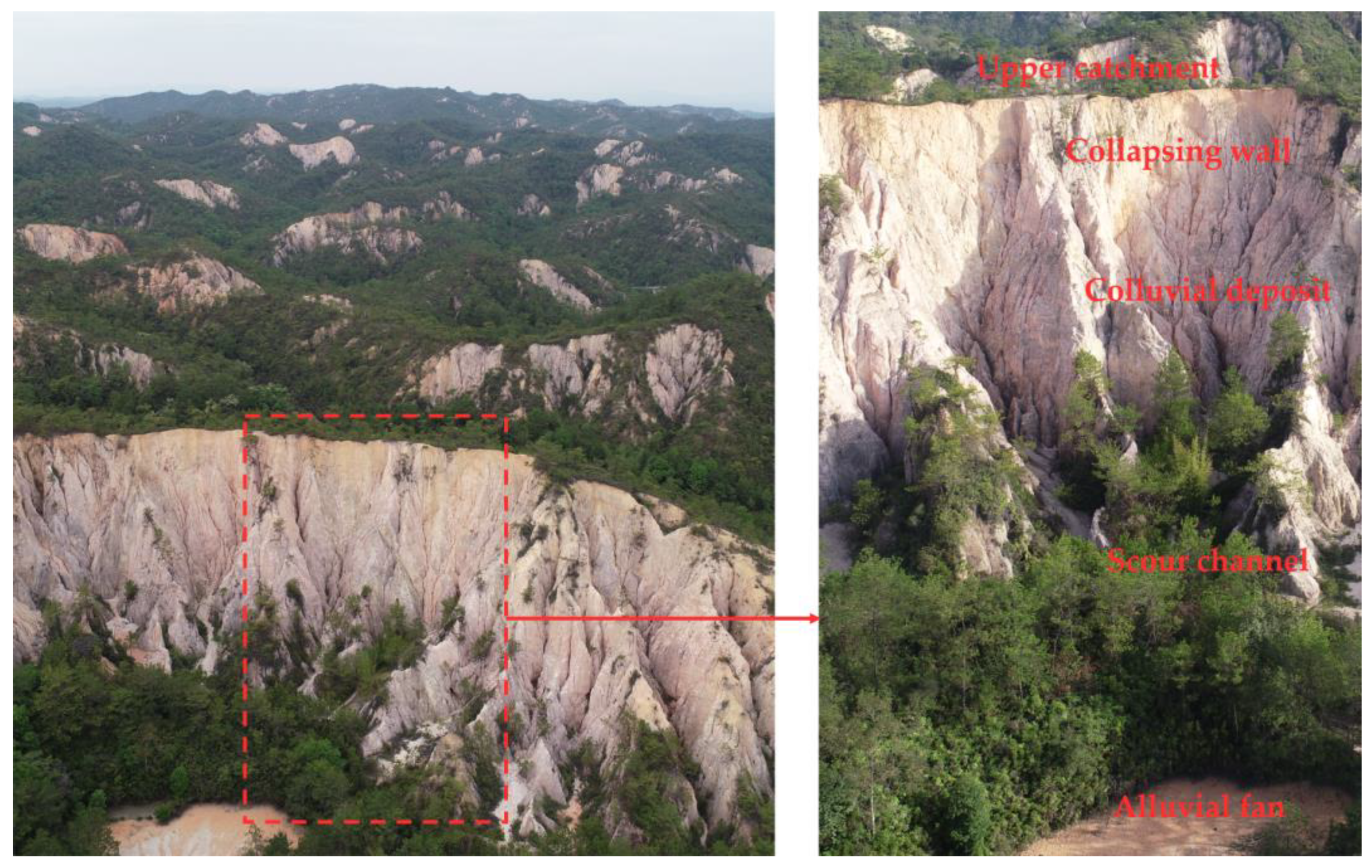

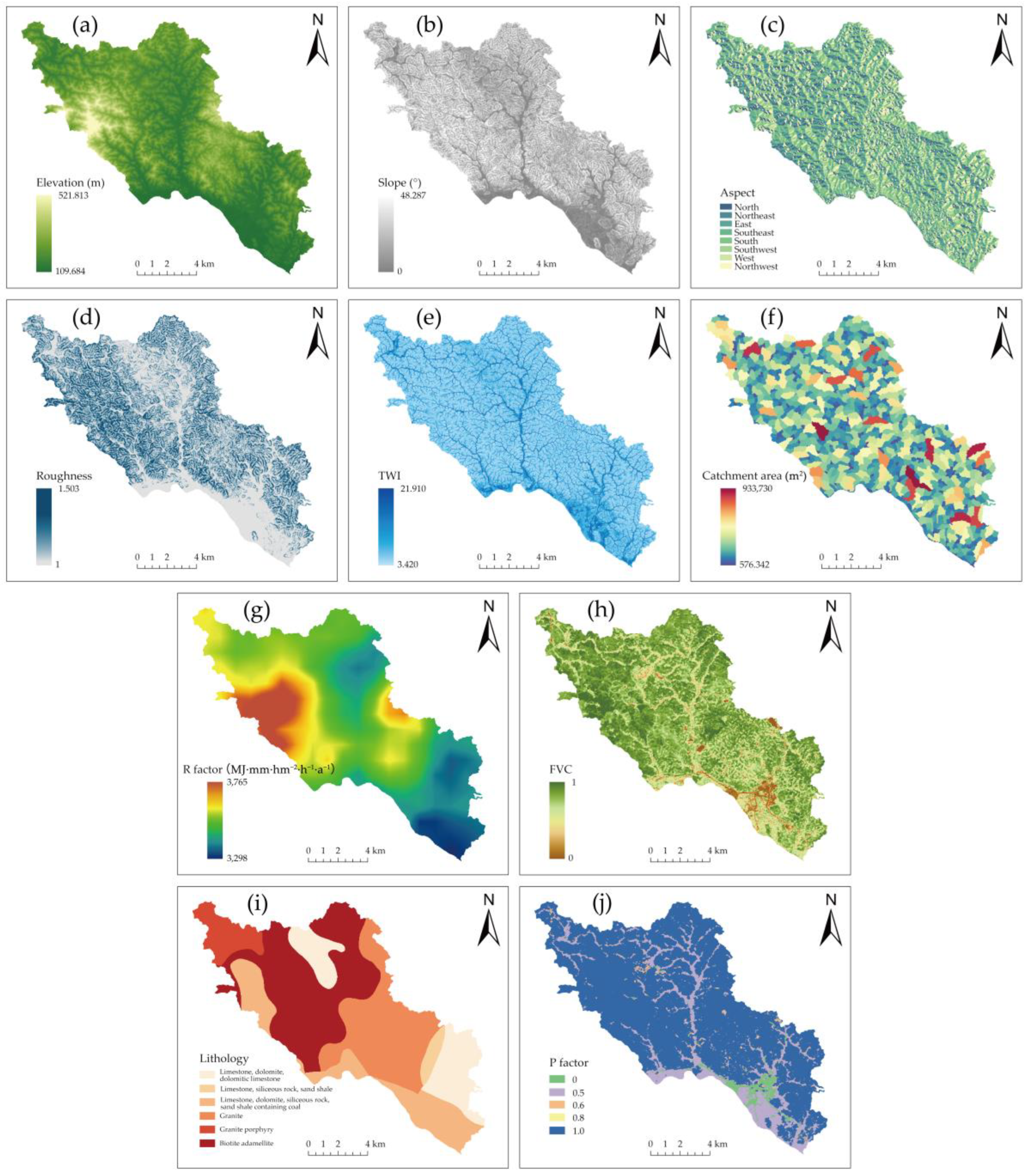



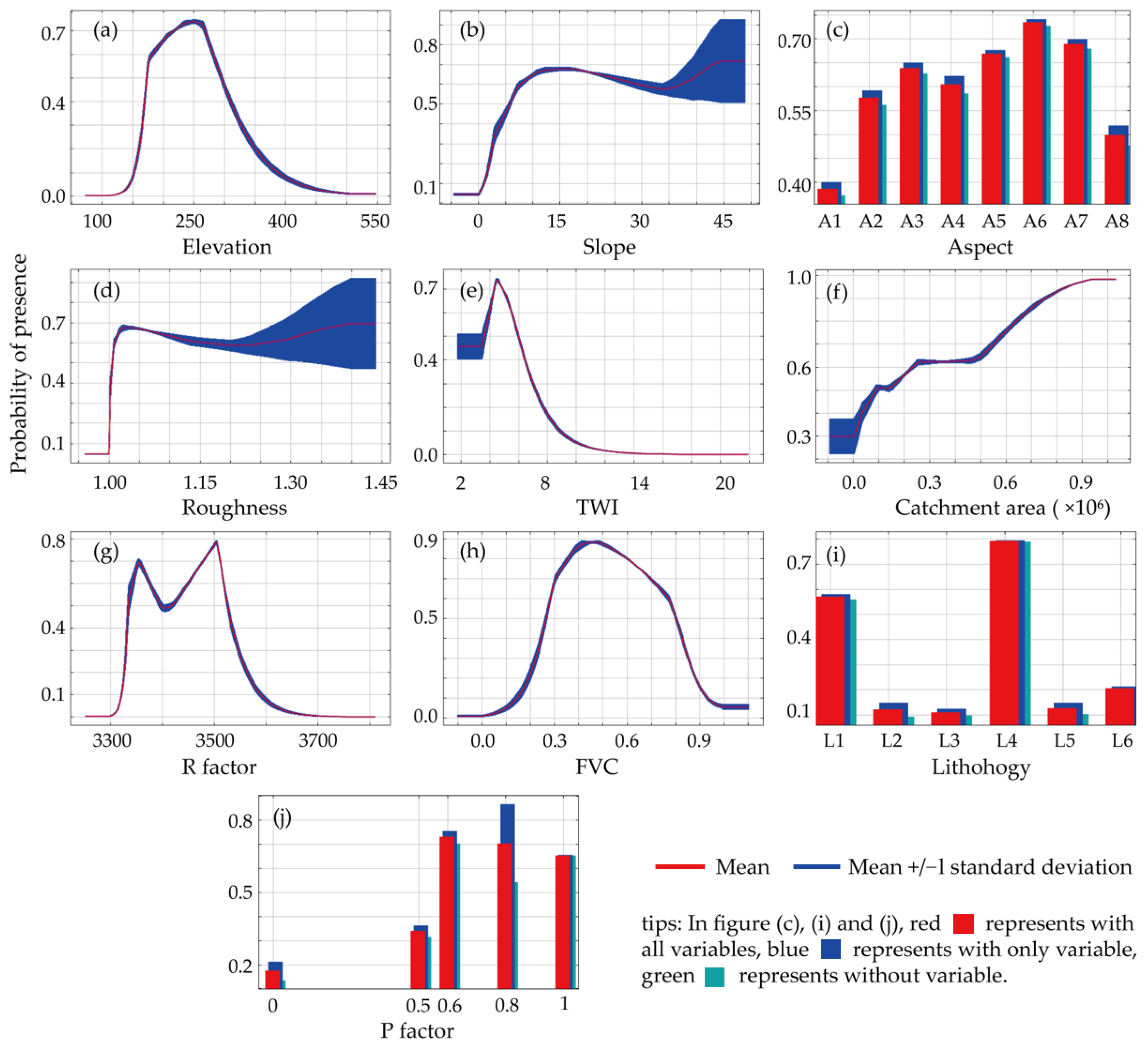
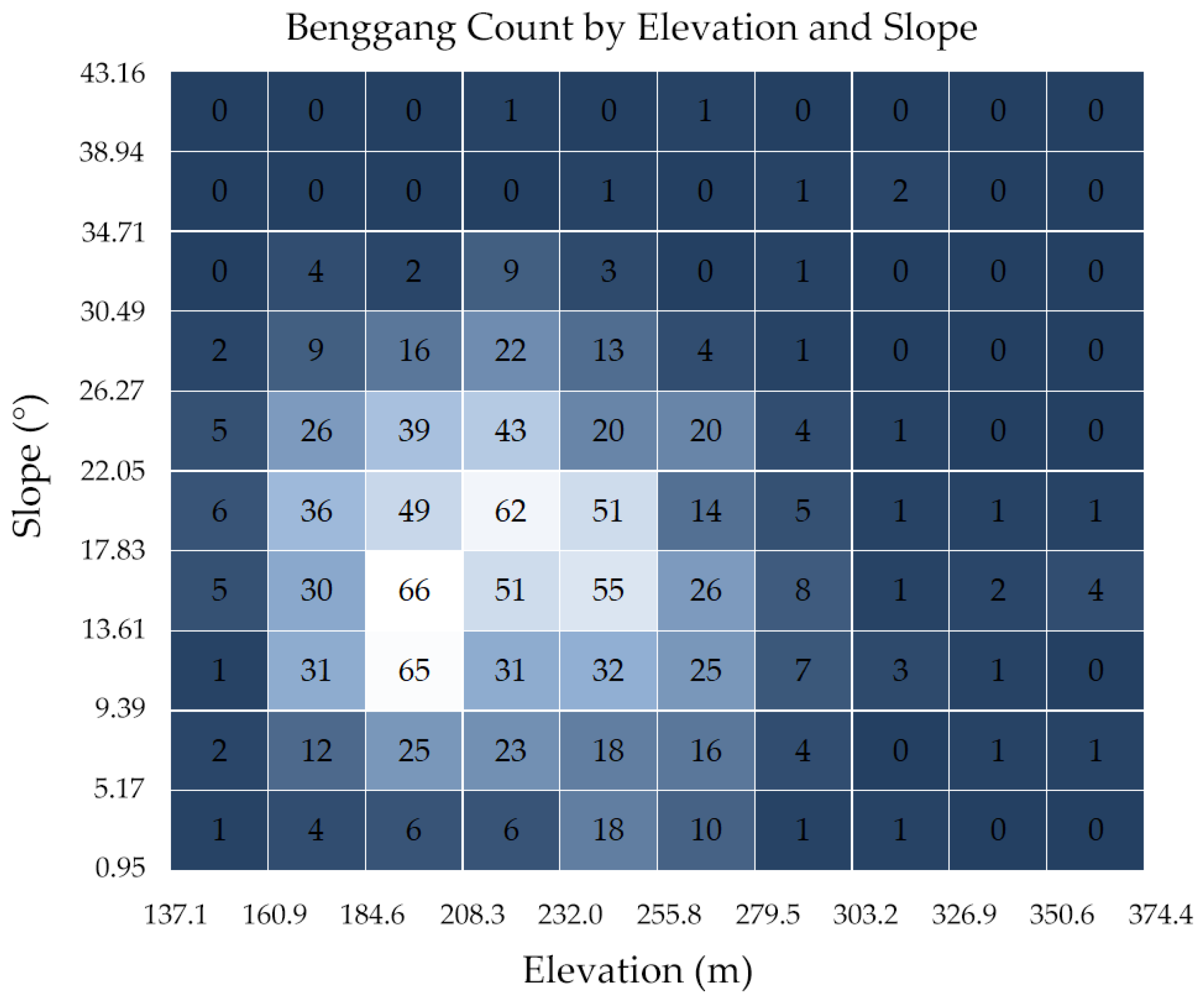

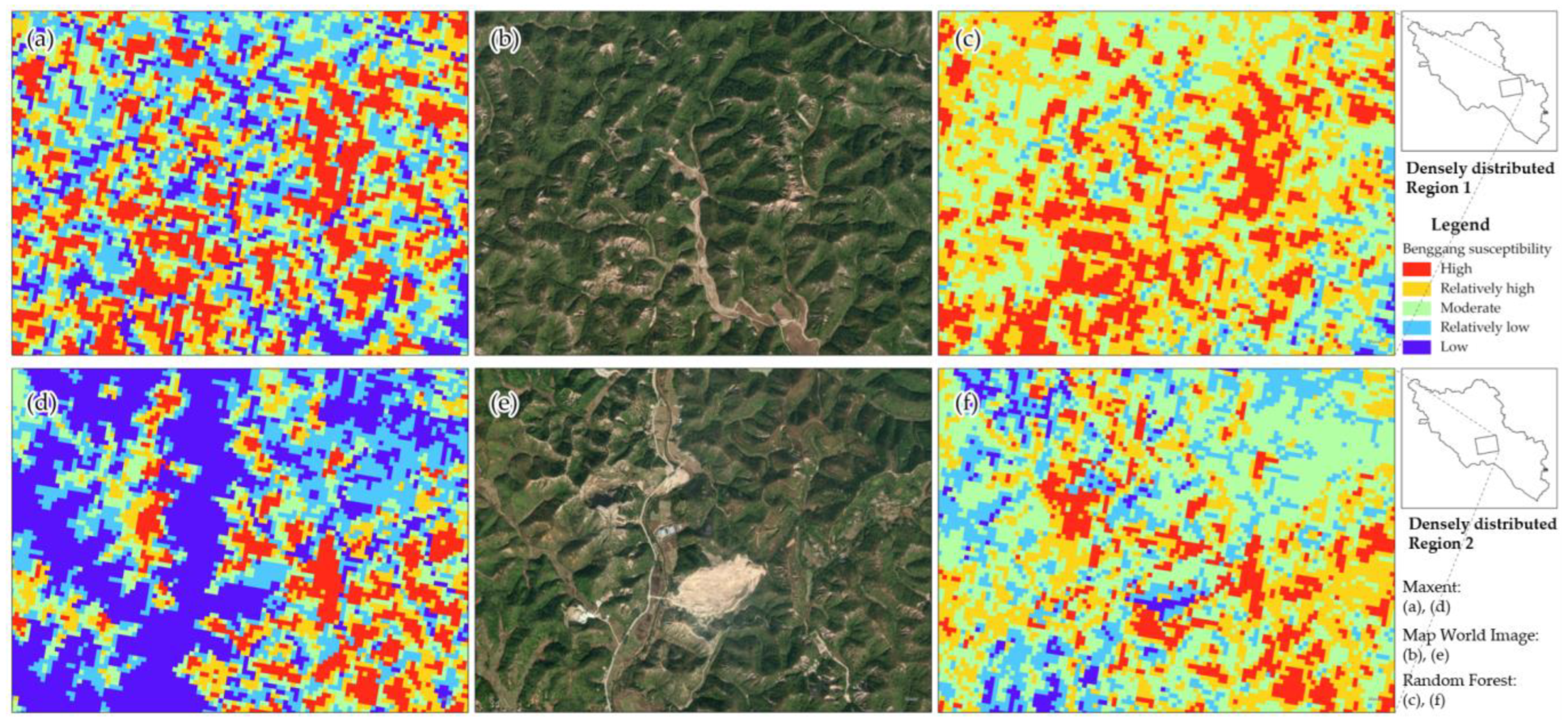

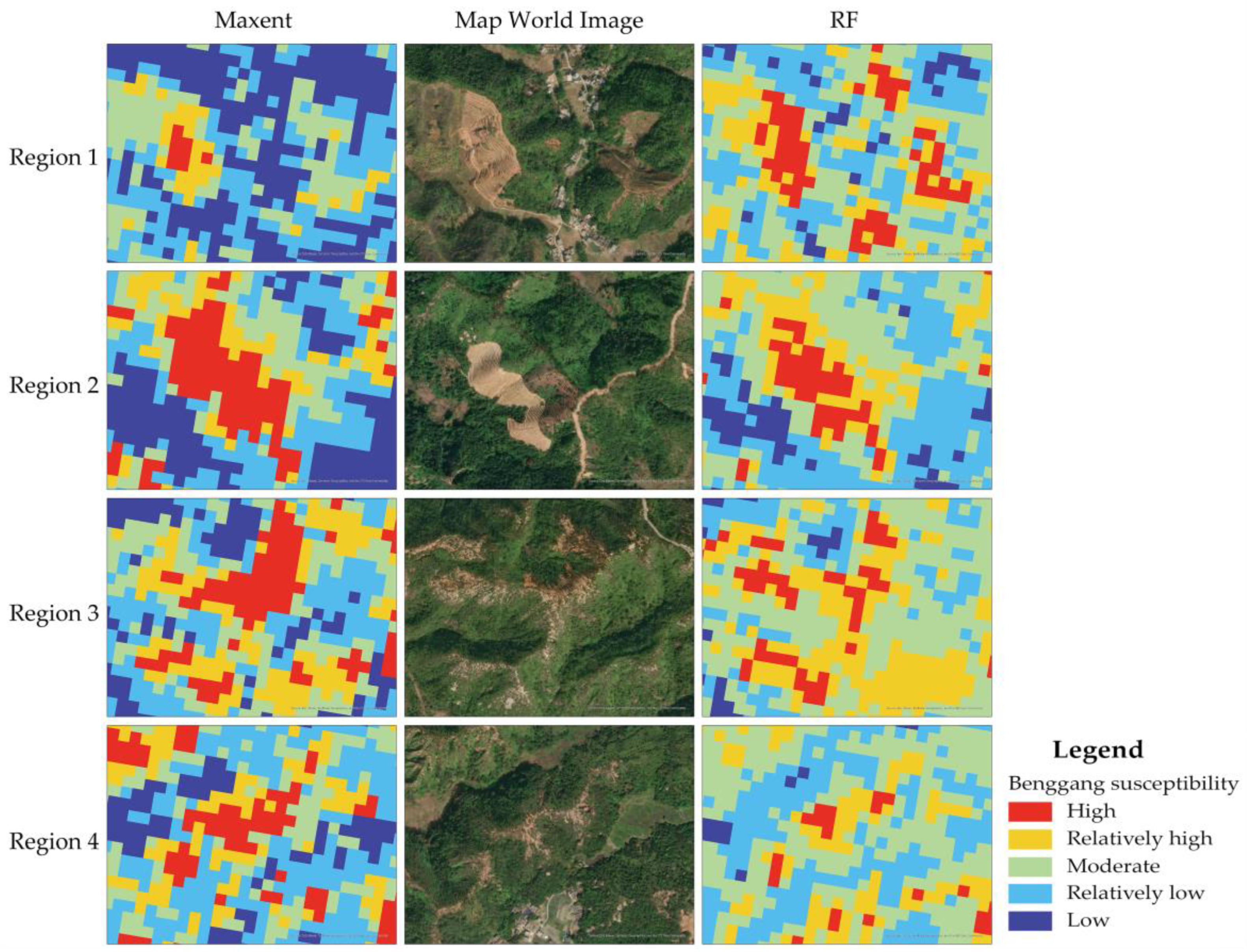
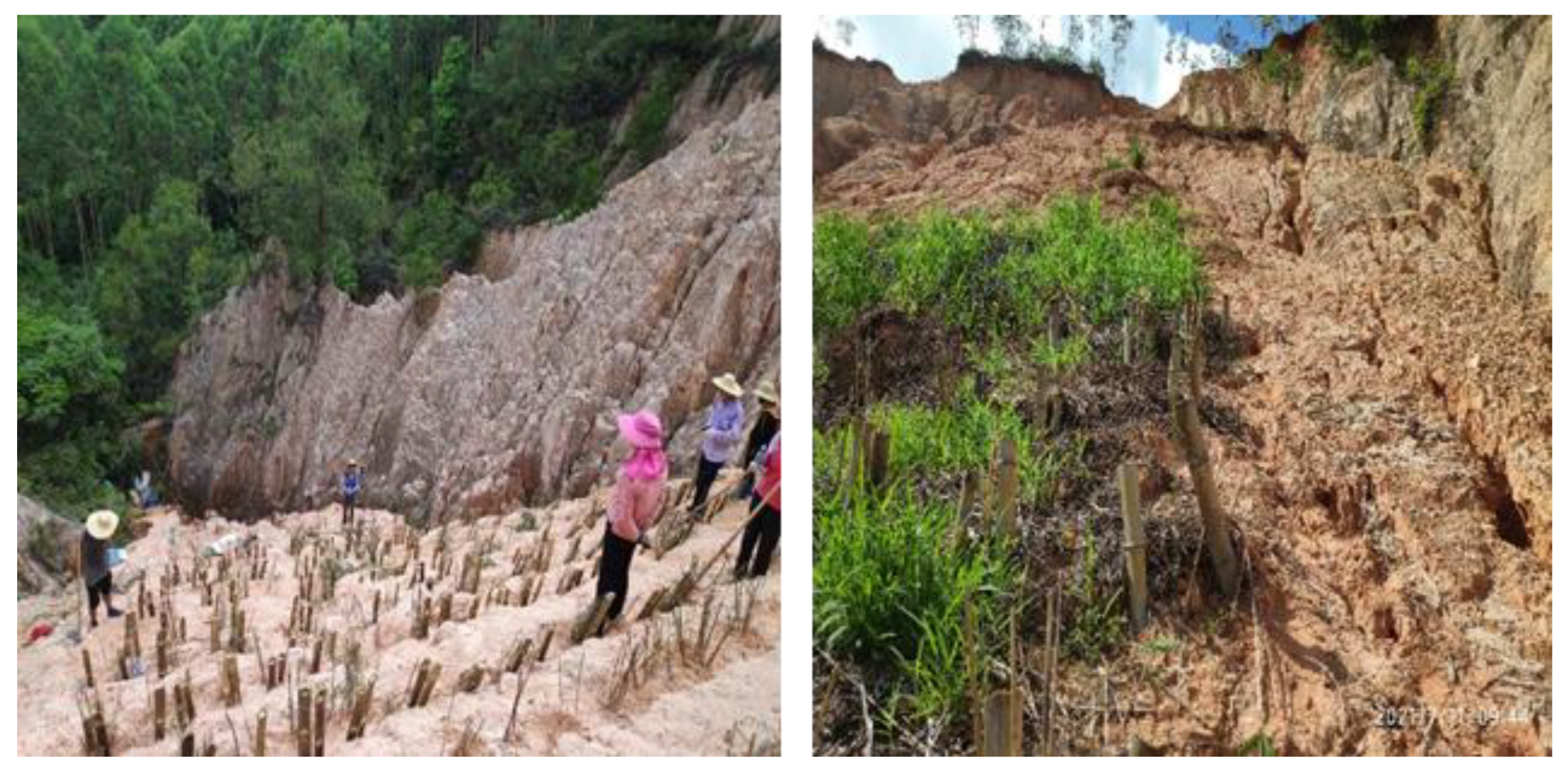
| Elevation | Slope | Aspect | Roughness | TWI | Catchment Area | R Factor | FVC | Lithology | P Factor | |
|---|---|---|---|---|---|---|---|---|---|---|
| Maxent | 40.2 | 0.1 | 0.9 | 0.2 | 5.0 | 0.5 | 14.4 | 32.1 | 6.0 | 0.6 |
| RF | 18.9 | 3.6 | 6.4 | 6.5 | 10.1 | 6.5 | 12.0 | 27.6 | 6.8 | 1.6 |
| Bh Rate | High | Relatively High | Moderate | Relatively Low | Low | |
|---|---|---|---|---|---|---|
| Maxent | 54.16 | 4.90 | 6.03 | 10.18 | 21.46 | 57.43 |
| RF | 48.92 | 5.98 | 17.14 | 31.43 | 30.39 | 15.06 |
| AUC | Moran’s I | H-H Rate | L-L Rate | Non-Significant Rate | |
|---|---|---|---|---|---|
| Maxent | 0.885 | 0.7298 | 19.34 | 38.41 | 40.75 |
| RF | 0.927 | 0.7021 | 13.84 | 13.03 | 72.04 |
Disclaimer/Publisher’s Note: The statements, opinions and data contained in all publications are solely those of the individual author(s) and contributor(s) and not of MDPI and/or the editor(s). MDPI and/or the editor(s) disclaim responsibility for any injury to people or property resulting from any ideas, methods, instructions or products referred to in the content. |
© 2024 by the authors. Licensee MDPI, Basel, Switzerland. This article is an open access article distributed under the terms and conditions of the Creative Commons Attribution (CC BY) license (https://creativecommons.org/licenses/by/4.0/).
Share and Cite
Ou, H.; Mu, X.; Yuan, Z.; Yang, X.; Liao, Y.; Nguyen, K.L.; Sombatpanit, S. Mapping Benggang Erosion Susceptibility: An Analysis of Environmental Influencing Factors Based on the Maxent Model. Sustainability 2024, 16, 7328. https://doi.org/10.3390/su16177328
Ou H, Mu X, Yuan Z, Yang X, Liao Y, Nguyen KL, Sombatpanit S. Mapping Benggang Erosion Susceptibility: An Analysis of Environmental Influencing Factors Based on the Maxent Model. Sustainability. 2024; 16(17):7328. https://doi.org/10.3390/su16177328
Chicago/Turabian StyleOu, Haidong, Xiaolin Mu, Zaijian Yuan, Xiankun Yang, Yishan Liao, Kim Loi Nguyen, and Samran Sombatpanit. 2024. "Mapping Benggang Erosion Susceptibility: An Analysis of Environmental Influencing Factors Based on the Maxent Model" Sustainability 16, no. 17: 7328. https://doi.org/10.3390/su16177328
APA StyleOu, H., Mu, X., Yuan, Z., Yang, X., Liao, Y., Nguyen, K. L., & Sombatpanit, S. (2024). Mapping Benggang Erosion Susceptibility: An Analysis of Environmental Influencing Factors Based on the Maxent Model. Sustainability, 16(17), 7328. https://doi.org/10.3390/su16177328








